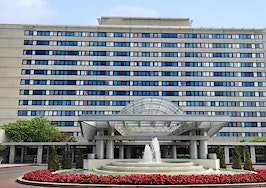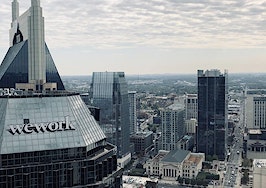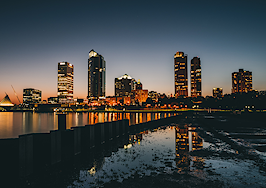In these times, double down — on your skills, on your knowledge, on you. Join us Aug. 8-10 at Inman Connect Las Vegas to lean into the shift and learn from the best. Get your ticket now for the best price.
Salt Lake City’s downtown is surging, with activity in the city’s urban core up 39 percent above pre-pandemic levels, according to new research analyzing activity in downtowns throughout the U.S.
Still, the city’s commercial real estate market reflects a trend that’s happening across the U.S. today: Office buildings, which have become the focal point of the ongoing real estate slowdown, are selling at half-off.
A building in Salt Lake City that could have sold for $350 per square foot two years ago instead sold recently for less than half that, said Kip Paul, vice chairman of investment sales for Cushman & Wakefield in Salt Lake City.
“That shows you how dramatic the office is at the moment,” Paul said.
Experts told Inman a slate of office buildings employers no longer want are weighing on downtowns across the country, and the situation might stay that way unless the buildings are turned into something new, like housing. There are some signs that investors are answering the call.
In 2023, the number of office-to-residential conversions soared to the highest level on record as businesses reduced office footprints nationwide after work-from-home mandates of early 2020 eased into a begrudging acceptance of remote work by many employers. But in order for downtowns to rebound from high vacancy rates, the trend needs to continue, commercial real estate experts told Inman.
The good news, experts say, is that investors have shown an interest in scooping up discounted office buildings and turning them into something new — at least, when the costs of converting aren’t prohibitive.
“If those buildings remain unattractive and un-leased, it’s going to continue to weigh on the vacancy rate,” said Jessica Morin, head of office research for CBRE. “Either they’re removed from inventory by conversion, demolition or analysts just completely cut it out because they know it’s not really competing with everything else.”
More offices are sitting empty
In San Francisco, the University of Toronto research found its downtown activity — as measured using cellphone data of visitors — stands at just one-third the level it was before the pandemic began.
Cellphone data tracking visitation levels in New York City show that office building activity is still at just 61 percent of what it was before the pandemic, according to newly released data from the Real Estate Board of New York.
If all that wasn’t troubling enough for the owners of office buildings, recent reports indicate the long-term outlook isn’t good: The run of high office vacancy rates driven in large part by remote work will continue and it will impact the broader office market until the owners improve the buildings.
The hardest hit buildings include older office buildings that don’t have the modern amenities that are capable of attracting companies and their employees back into the office.
CBRE suggested the owners consider converting their spaces into residential, mixed-use, hotels or a modernized office building.
“How long the market takes to rebalance could well depend on what happens to the hardest-hit buildings,” according to a report from CBRE.

The demand for office buildings quickly slowed during the coronavirus pandemic, with the vacancy rate climbing to a 30-year high. | CBRE
The office vacancy rate hit 17.3 percent in the fourth quarter, a 30-year high, and more companies that were locked into leases were looking to sublet their spaces, according to CBRE.
That’s up from about 12 percent shortly before the pandemic, CBRE said.
Companies that remain in office are shrinking the footprint of their spaces by about 20 percent compared to five years ago, Morin said. That all ads up to more space in more buildings sitting empty.
But one segment of the office market is driving that vacancy rate, notably buildings erected between 1980 and 2009 in higher crime areas and without modern amenities.
CBRE calls them the “hardest hit buildings,” or HHBs, and they’re primed to continue weighing on markets across North America. These are typically Class C buildings, or older and without the modernized spaces seen in Class A office.
Those buildings accounted for 80 percent of the vacant office space added to the U.S. office market from 2020 through 2023.
“There’s going to be a segment, really the hardest hit segment, that’s going to struggle to find tenants for those spaces,” Morin said. “It will continue to weigh on the market.”
The sort of reckoning that started with the onset of the pandemic hasn’t impacted the multifamily market like it has office, and recent reports make clear that multifamily buildings have lower vacancy rates and higher rent growth than office.
There are 4 billion square feet of office space in the U.S. If the buildings aren’t repurposed or converted, they’ll continue driving overall high vacancy rates and open up another 103 million square feet of vacant space in the coming years, CBRE said.
San Francisco acts as sort of ground zero for the trouble for office buildings. With nearly one in three office spaces vacant in the first three months of the year, city officials are talking about changing regulations to make it easier for office conversions.
Mayor London Breed is working with other local politicians to streamline the lengthy permitting and public comment periods that delay housing, specifically with a goal of spurring more office-to-housing conversions.
“There are other discussions about arts facilities and music and biotech,” said Janan New, director of the San Francisco Apartment Association. “Everything is on the table because economically we’re just getting killed here.”
A surge in conversions
There’s been chatter over the years about the possibility for more office buildings to be turned into something new, and in 2023, the number of ongoing and planned conversions more than doubled from pre-pandemic levels, according to CBRE data.
More than 16 million square feet of office space is in some process of being retrofitted into something new this year.
 But not every building is suitable for being repurposed, experts told Inman.
But not every building is suitable for being repurposed, experts told Inman.
The buildings with high vacancy rates typically have floor area sizes that are much larger than what’s ideal for conversion, Morin said. If a building’s floor plate is too big, it becomes more expensive and less feasible to convert.
“Conversions are most attractive in buildings that are less than 20,000 square and more specifically less than 15,000 square feet,” she said.
Issues with the building’s existing layout, elevator locations and mechanical can add more complications to such projects.
“Unfortunately, many commercial buildings simply were not designed for high-density residential living,” said Ben Johnston, chief operating officer of Kapitus. “Not all buildings will have this problem, but there will be significant reinvestment cost in transitioning these properties to new uses.”
Architecture firm Gensler specializes in this type of work and has analyzed hundreds of buildings in cities across North America to help investors determine whether a building is suitable to be converted into something new. It found that only 30 percent of buildings are suitable to be converted into residential buildings.
CBRE data suggests that there are five primary uses for outdated office buildings: Multifamily, life sciences office, hotels, mixed-use and industrial.
With 477 office buildings currently at some stage of the conversion process in the U.S., about 36 percent of them have been office-to-residential, according to data tracked by CBRE.
When conversion can be done, the results are often unique.
More to come?
Gensler has a growing list of projects for which it helps its investor clients update outdated office buildings. Among them was the 605,000-square-foot Franklin Tower in Philadelphia.
The firm helped to convert the building into a mixed-use tower with residential units above 13,000 square feet of retail on the ground level.
Perhaps highlighting the trend, Steven Paynter, a principal at Gensler, said plans to keep eight stories of office space within the building were scrapped in favor of more residential space and amenities.
“As the value of office continues to drop, the viability of converting to residential increases,” Paynter said. “In any city where there’s older office stock and a strong demand for housing then it’s happening.”
It’s not just rentals, either. Office-to-residential conversion can add to the stock of for-sale housing in cities across North America.
In a suburb of Toronto, Gensler took on a bigger project of helping to convert four office buildings with nearly 1 million square feet into 1,228 housing units.
Overcoming the site’s shape was complicated, Gensler said, and an easement splitting the property allowed the company to add more ground-floor retail and engaging space.
In a suburb of Washington D.C., investors retrofitted a suburban office building into 112 apartments. The estimated cost of converting the building was 23 percent less than the estimated cost to build new, according to CBRE.
Paynter said the trend is cyclical and was accelerated by COVID. Similar trends occurred in the 1970s in New York, when the city retrofitted buildings from the early 20th century into housing. Again in the 1990s, buildings from the 1940s were being converted, he said.
“Now we’re converting these 60s and 70s buildings,” he said. “The building becomes outdated, we find a new use for it or tear it down. Then it happens again.”

SAN FRANCISCO, CALIFORNIA – OCTOBER 27: An office sits vacant on October 27, 2022 in San Francisco, California. According to a report by commercial real estate firm CBRE, the city of San Francisco has a record 27.1 million square feet of office space available as the city struggles to rebound from the Covid-19 pandemic. The US Census Bureau reports an estimated 35% of employees in San Francisco and San Jose continue to work from home. (Photo by Justin Sullivan/Getty Images)
A rush to luxury?
Morin said due to the costs of conversion, many new housing projects will likely command high prices.
Though if the hardest-hit office buildings continue dropping in price, it may widen the margins for developers to spend more turning a difficult space into something new.
But there are incoming incentives for investors who can pick up buildings at deep discounts and somewhat easily convert them, earning higher profits.
“The conversions that are taking place are probably going to be luxury because of the cost to convert,” Morin said. “They are going to be residential conversions with higher rents.”
“That could have a trickle-down effect once you increase the existing supply,” she added.
Older office spaces often have taller ceilings that are considered desirable in an apartment of condo project, Paynter said. The buildings can also use big floor plates to pack in more amenities for tenants.
Still, not all projects are being targeted toward the highest earners.
One project, in Salt Lake City, seeks to convert an aging medical office building into low-income housing, with construction subsidized by low-income housing tax credits to pay for the project.
Rent has been wavering after a period of record-high growth during the pandemic, peaking at 17.1 percent in 2021.
While rent has been growing at a much slower rate, the typical U.S. rent is now $1,874 a month, up from $1,594 a month in March 2020, according to Zillow.
Get Inman’s Property Portfolio Newsletter delivered right to your inbox. A weekly roundup of news that real estate investors need to stay on top, delivered every Tuesday. Click here to subscribe.






























